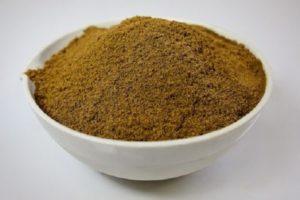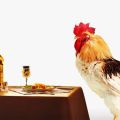How much fishmeal to give to laying hens, the benefits and rules for using different types
For the rapid growth and development of poultry in a farm or household, its diet is of paramount importance. He must be rich and balanced. You should know what is the use of feeds of different composition, how much fishmeal to give to laying hens to replenish a number of important microelements. This knowledge helps not only in raising poultry, but also in increasing its productivity, strengthening immunity.
What is fishmeal made of and its composition
Raw materials for the additive - tissues and bones, fish production waste. Any fish and crustaceans are used. Flour is produced both at sea, on fishing vessels, and onshore. To do this, fish is boiled, dried, dried and chopped. The result is a product - fatty or dry flour. It contains different components, depending on the manufacturer. The main ones are:
- 65% protein - is necessary for the formation of eggs, the acceleration of bird growth, the elasticity of the plumage;
- 14% fat - needed to strengthen the immune system, reduce the percentage of chicken mortality, improve the functioning of the gastrointestinal tract;
- 14% ash is a source of calcium;
- 8% polyunsaturated acids - strengthens the immunity of laying hens.
The fish meal contains vitamins, macro- and microelements.
Benefits for chickens
The use of the supplement in the diet of chickens contributes to many positive changes:
- the bird's immune system is strengthened;
- egg production increases significantly;
- nutrients are absorbed better;
- plumage of young animals is faster;
- chickens become more active, more energetic;
- young animals quickly gain weight;
- the profitability of production increases;
- product quality is improved.
How much fishmeal can you give?
Despite the obvious benefits of using fish concentrate, the dosage must be followed precisely to maximize the health benefits of chickens. Flour can make up from 3% to 10% of the bird's diet.
If the feed is not balanced in amino acids, then its use is especially important.
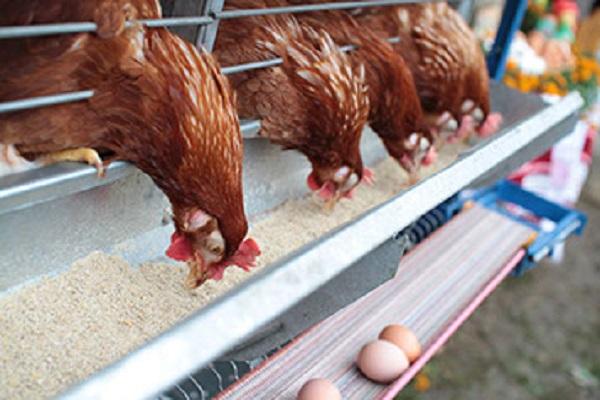
It should be remembered that two weeks before slaughter, fishmeal should be excluded from the diet of the birds, as the meat may have an aftertaste. Exceeding the dose leads to the formation of stomach ulcers due to an increase in the concentration of cadaverine and histamine.
Chickens for laying hens
According to the recommendations of experts, each layer can receive at least 10 g of fishmeal per day. Moreover, it should not exceed 7% of the total daily feed of chickens.As a result of adding to the diet, the digestion of birds improves, eggs are more nutritious, their number increases significantly, chickens are less likely to get sick.
For broilers
When raising broilers, breeders are obliged to introduce fishmeal into their diet. The material costs for the additive are more than offset by the increased yield of poultry meat. Broilers grow quickly. Their digestion is normalized, obesity does not develop. Regular use of the fish supplement leads to the fact that poultry meat acquires a rich taste, becomes soft and juicy.
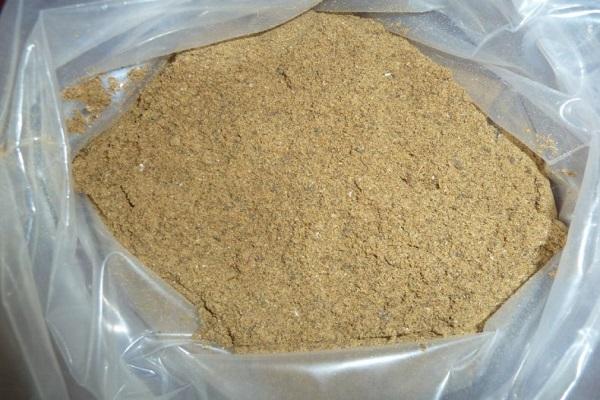
For broilers, there is a scheme for using the additive. The dosage increases gradually:
- do not add fishmeal in the first 5 days;
- in the next 5 days, the consumption rate is from 0.5 to 1 g per individual;
- from 11 to 20 days - from 1.5 to 2 g per broiler;
- from 21 to 30 days the dose is increased to 3 g per bird;
- in the second month of life, the dose is 5 g per individual.
Exceeding the dose is unacceptable, since gout and a violation of protein metabolism are possible.
Chickens
With the regular use of fishmeal as an additive to chicken feed, the productive characteristics of the young are significantly increased:
- the growth and development of the bird is accelerated, it quickly enters the period of sexual maturity;
- immunity is strengthened, and the survival rate of chickens increases;
- young animals are rapidly gaining weight and quickly reach the required slaughter weight.
From the 15th day of life, fishmeal is included in the diet of chickens in an amount of 2% of the total volume of feed, from the 20th day - 5%. The average feed weight is 2 g per day per chicken.
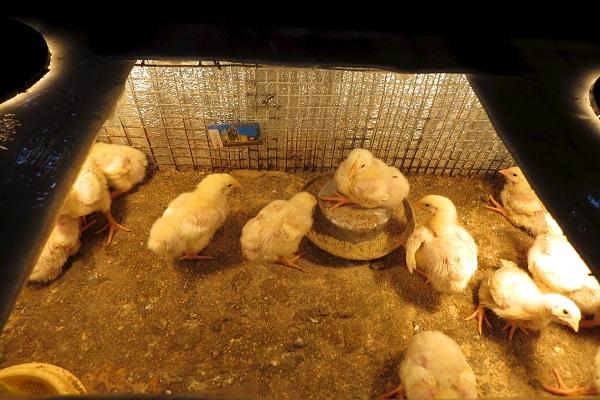
When is it worth to refuse
Despite the fact that the instructions for using flour indicate that there are no contraindications for use, in some cases it is worth refusing to use it:
- if the fat content is very high (more than 18%);
- if the rules for its storage are not followed;
- before slaughtering poultry, so as not to get meat with the smell and taste of fish.
Flour should be stored in a dry, darkened room with good ventilation, humidity up to 75% and at an air temperature not exceeding 30 ⁰С. The shelf life in the original packaging is 1 year.

Is it possible to give raw fish to chickens
For laying hens, fish is a valuable product enriched with vitamins, minerals and trace elements. You need to know what breed and in what form should be fed to chickens, and what should be discarded.
River fish are good for poultry, but they are often infested with helminths, as many pathogens develop in fresh water. When parasites enter the digestive tract of a bird, they can quickly develop and infect the entire flock.
Inhabitants of salty sea water are much less likely to be affected by coelenterates, therefore, sea fish are more often fed to chickens (sprat, blue whiting, pollock, herring).
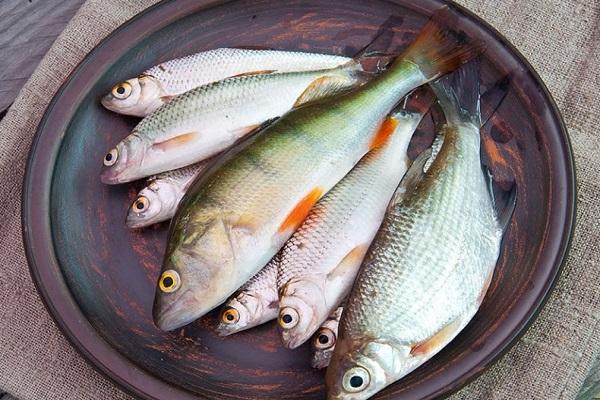
Salted fish
This type of fish products is one of the most undesirable for poultry, since salt must enter its body in strictly limited quantities - no more than 0.3% of the daily feed ration.
Salted fish can be given to chickens only after prolonged soaking. Most often, poultry farmers do not risk using such a product for feeding, so as not to exceed the salt intake.
If the product has been soaked for a long time, it is given to the bird in an amount of 70 g per bird per week.
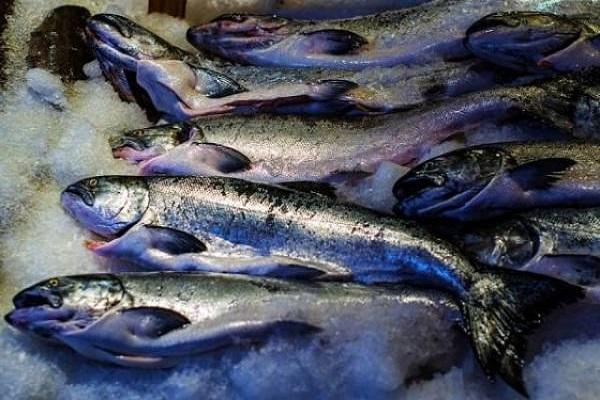
Raw fish
The rules for feeding raw fish depend on the age and characteristics of the bird. Many farmers and backyard owners do not allow feeding hens with such a product, because they believe that eggs acquire an unpleasant taste and smell.
When feeding a poultry raw product, it is worth considering the rules:
- seafood fish is added to chicken feed in the form of minced meat;
- fresh river must be heat treated before feeding;
- Chickens are not fed raw fish.
Boiled
Most often, poultry farmers use boiled fish - a completely safe product if it is brought to a state of softened bones. For this purpose, it is cooked in boiling water for at least 20 minutes. The broth can be used for wet mash. Then it is ground in a meat grinder or, divided into pieces, is given to the bird. The consumption rate is 70 g per chicken per week.
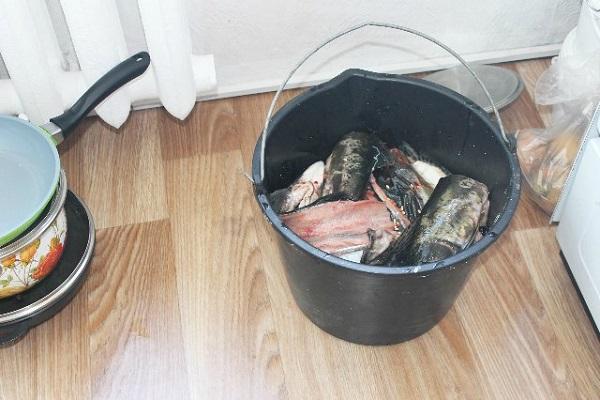
Fish meal
An alternative to fresh product is flour, which is obtained as a result of processing waste from fish enterprises. Low-fat (2-3%), which is well stored, is valued higher. The advantages of the product include:
- high content of protein, minerals;
- calcium affects the quality of the shell and the shelf life of eggs;
- protein contributes to the rapid growth of the bone system of broilers and their muscle mass;
- the additive is easy to store and use;
- the use of bone meal can reduce the cost of growing poultry and obtaining eggs.

